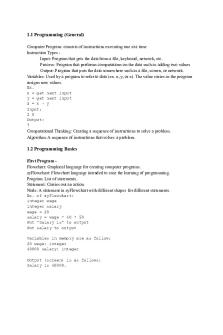Programming Notes PDF

| Title | Programming Notes |
|---|---|
| Author | Almas Hakim |
| Course | Programming Fundamentals |
| Institution | Western Sydney University |
| Pages | 3 |
| File Size | 168.8 KB |
| File Type | |
| Total Downloads | 75 |
| Total Views | 155 |
Summary
Programming Fundamentals Notes...
Description
LECTURE 2 Clara’s vocabulary • • • •
turnLeft(); - make Clara turn 90 degrees to the left move(); - make Clara move one cell forward putLeaf(); - put leaf at Clara’s current position removeLeaf(); - remove leaf at Clara’s current position
New Commands: • • • •
turnRight(); - make Clara turn 90 degrees to the right treeFront(); - check if there is tree one cell in front onLeaf(); - check if there is a leaf at current position stop(); - stop execution
act() vs run() • •
Code written inside the run() method are executed once and then the execution is over If you write your code inside the act() method this will allow to execute all the code inside again and again, until the stop() command is encountered.
Flow of Control • •
• •
Unless specified otherwise, the order of statement execution through a method is linear: one statement after the other in sequence Some programming statements modify that order, allowing us to: – decide whether or not to execute a particular statement, or – perform a statement over and over, repetitively These decisions are based on a boolean expression (also called a condition) that evaluates to true or false The order of statement execution is called the flow of control
Conditional Statements • • • •
A conditional statement lets us choose which statement will be executed next Therefore they are sometimes called selection statements Conditional statements give us the power to make basic decisions Some conditional statements in Java are – the if statement – the if-else statement
The if Statement •
The if statement has the following syntax:
•
An example of an if statement: if ( onLeaf() ) removeLeaf();
turnLeft(); turnLeft(); move(); First, the condition is evaluated. Clara is either on leaf or not. If the condition is true, the leaf is removed. If it is not, the removeLeaf() statement is skipped. Either way, the call to turnLeft()is executed next. Logic of an if statement
Boolean Expressions •
•
A condition often uses one of Java's equality operators or relational operators, which all return boolean results: == equal to != not equal to < less than greater than = greater than or equal to Note the difference between the equality operator (==) and the assignment operator (=)
The if-else Statement •
An else clause can be added to an if statement to make an if-else statement if ( condition ) statement1; else statement2;
• •
If the condition is true, statement1 is executed; if the condition is false, statement2 is executed One or the other will be executed, but not both
Logic of an if-else statement...
Similar Free PDFs

Programming Notes
- 3 Pages

C programming notes
- 4 Pages

C 173 Programming Notes
- 16 Pages

CS8251 c programming notes
- 127 Pages

R Programming Lecture Notes
- 30 Pages

Computer Programming Notes
- 39 Pages

Web Programming Notes
- 57 Pages

Programming Fundamentals Notes
- 2 Pages

C programming notes
- 65 Pages

C programming complete notes
- 119 Pages

Web Programming Lecture Notes
- 246 Pages

CS8651-Internet Programming notes 2
- 174 Pages

Internet Programming - Lecture notes 3
- 174 Pages
Popular Institutions
- Tinajero National High School - Annex
- Politeknik Caltex Riau
- Yokohama City University
- SGT University
- University of Al-Qadisiyah
- Divine Word College of Vigan
- Techniek College Rotterdam
- Universidade de Santiago
- Universiti Teknologi MARA Cawangan Johor Kampus Pasir Gudang
- Poltekkes Kemenkes Yogyakarta
- Baguio City National High School
- Colegio san marcos
- preparatoria uno
- Centro de Bachillerato Tecnológico Industrial y de Servicios No. 107
- Dalian Maritime University
- Quang Trung Secondary School
- Colegio Tecnológico en Informática
- Corporación Regional de Educación Superior
- Grupo CEDVA
- Dar Al Uloom University
- Centro de Estudios Preuniversitarios de la Universidad Nacional de Ingeniería
- 上智大学
- Aakash International School, Nuna Majara
- San Felipe Neri Catholic School
- Kang Chiao International School - New Taipei City
- Misamis Occidental National High School
- Institución Educativa Escuela Normal Juan Ladrilleros
- Kolehiyo ng Pantukan
- Batanes State College
- Instituto Continental
- Sekolah Menengah Kejuruan Kesehatan Kaltara (Tarakan)
- Colegio de La Inmaculada Concepcion - Cebu


